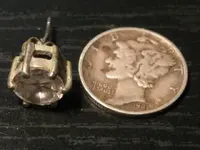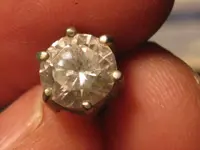You are using an out of date browser. It may not display this or other websites correctly.
You should upgrade or use an alternative browser.
You should upgrade or use an alternative browser.
Real of fake diamond?
- Thread starter Garabaldi
- Start date
SkyPirate
Bronze Member
- Joined
- Mar 31, 2009
- Messages
- 1,861
- Reaction score
- 83
- Golden Thread
- 0
- Location
- Raleigh North Carolina
- Detector(s) used
- Garrett AT Pro, Garrett ProPointer
- Primary Interest:
- All Treasure Hunting
Treasure_Hunter said:Are there any markings silver or gold?.....Usually for earring studs to have a chance for the stones to be real they are set in gold ...
Or Platinum
Upvote
0
Bigcypresshunter
Sapphire Member
- Joined
- Dec 15, 2004
- Messages
- 27,000
- Reaction score
- 3,340
- Golden Thread
- 0
- Location
- South Florida
- Detector(s) used
- 70's Whites TM Amphibian, HH Pulse, Ace 250
- Primary Interest:
- Beach & Shallow Water Hunting
#12- Put the diamond in some water. If it is real it will sink, and if it is fake it will float.mick56 said:
Upvote
0
mrs.oroblanco
Silver Member
- Joined
- Jan 2, 2008
- Messages
- 4,356
- Reaction score
- 427
- Golden Thread
- 0
- Location
- Black Hills of South Dakota
- Detector(s) used
- Tesoro Lobo & Garrett Stinger
- Primary Interest:
- All Treasure Hunting
I'm pretty sure the 2 water tricks only pertain to a stone that is NOT in a setting.
So, since this has a setting - its gonna sink no matter what it is.
B
So, since this has a setting - its gonna sink no matter what it is.
B
Upvote
0
foundinrolls
Full Member
Take the thing and run it under warm water for several minutes to remove as much of the debris as you can.
Then use a good magnifier or, better yet, a loupe. First look for visible cracks and chips on the edges of the facets. Look for out and out cracks as well. Then use the loupe to peer into the stone. If you see small black spots (specks) or white spots (specks) visible in the stone,...they are probably inclusions, as they are called and the stone is likely real.
If you see what looks like bubbles in the stone, it is likely fake. If you see nothing in the stone, It is likely fake unless the setting is white gold or platinum. A perfect diamond would not likely be set in silver.
I don't see any obvious crack or chips around the outer perimeter of the stone so that's good.
Also, if the stone is clear all the way through, that's a good sign, if the back side of the stone, (The pointed part) is coated or "silvered" , it is definitely a clunker. That's done to make a fake stone reflect more light.
Good Luck,
Bill
Then use a good magnifier or, better yet, a loupe. First look for visible cracks and chips on the edges of the facets. Look for out and out cracks as well. Then use the loupe to peer into the stone. If you see small black spots (specks) or white spots (specks) visible in the stone,...they are probably inclusions, as they are called and the stone is likely real.
If you see what looks like bubbles in the stone, it is likely fake. If you see nothing in the stone, It is likely fake unless the setting is white gold or platinum. A perfect diamond would not likely be set in silver.
I don't see any obvious crack or chips around the outer perimeter of the stone so that's good.
Also, if the stone is clear all the way through, that's a good sign, if the back side of the stone, (The pointed part) is coated or "silvered" , it is definitely a clunker. That's done to make a fake stone reflect more light.
Good Luck,
Bill
Upvote
0
Garabaldi
Bronze Member
- Joined
- Jun 28, 2009
- Messages
- 2,382
- Reaction score
- 99
- Golden Thread
- 0
- Detector(s) used
- Whites M6, Whites Pulse Diver, ETRAC.
- #26
Thread Owner
I agree with all of you. I believe it is fake. 
Thanks for all the suggestions. I have learned a lot about diamonds and fake diamonds.
Thanks for all the suggestions. I have learned a lot about diamonds and fake diamonds.

Upvote
0
Similar threads
- Replies
- 9
- Views
- 500
- Replies
- 5
- Views
- 812
- Replies
- 2
- Views
- 131
Users who are viewing this thread
Total: 1 (members: 0, guests: 1)








